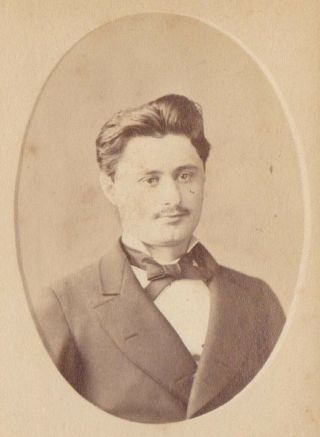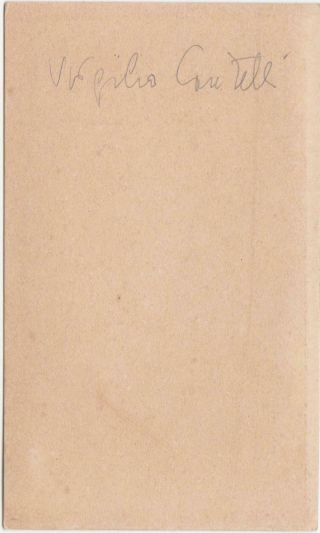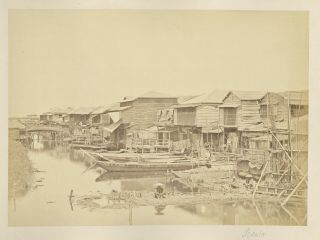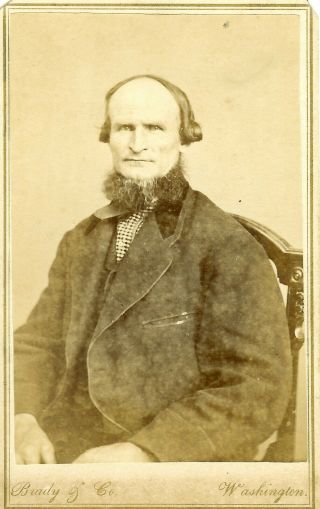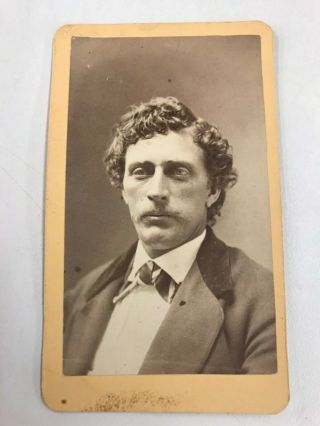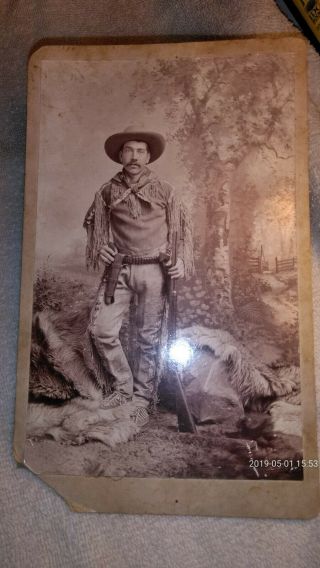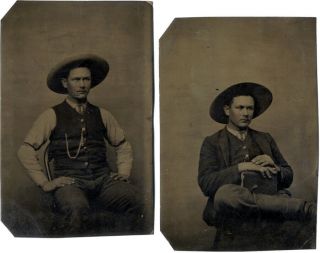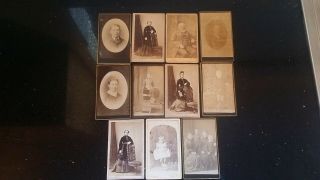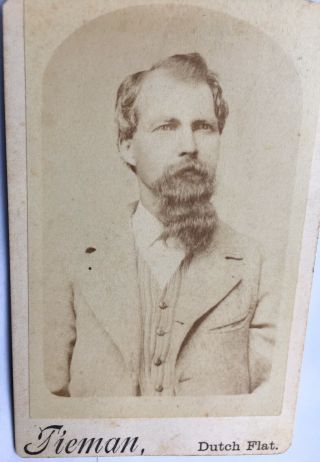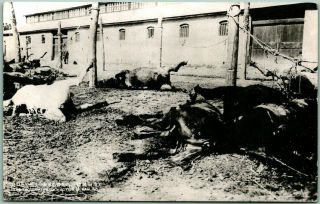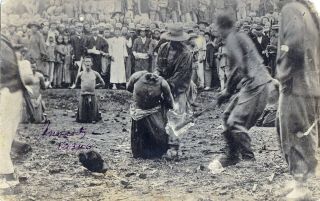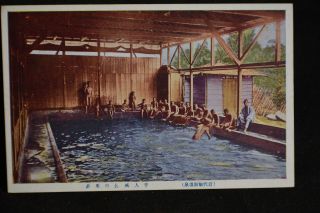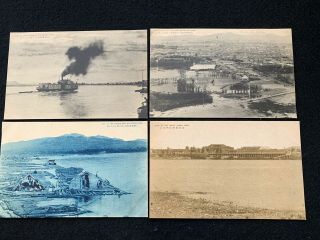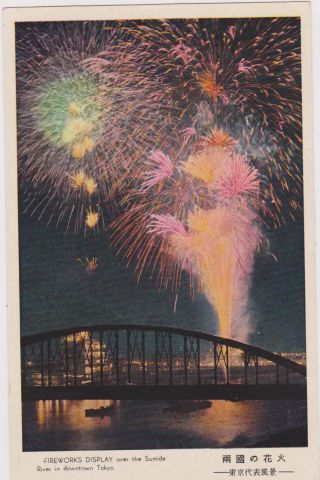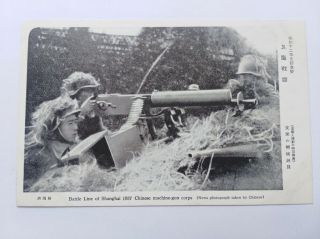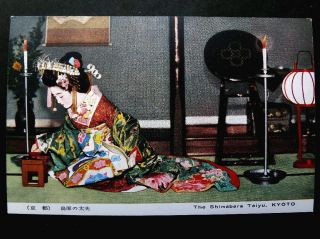1870s FELICE BEATO Yokohama Studio Western Man CDV PHOTO JAPAN Kimbei China
Item History & Price
| Reference Number: Avaluer:2834735 |
to Germany: 4 US$ by registered airmailto European countries: 8 US$ by DHL XS small package with tracking, items larger than 35 cm cost 14 US$ with tracking !
to overseas countries (outside Europe): 14 US$ by DHL XS small package with tracking, items larger than 35 cm cost 18 US$ with tracking !
Item Description:very, very rare antique / old Carte-de-Visite / CDV photo / photograph (NO postcard ! size of photo : 6, ...2 x 10, 5 cm) depicting a western gentleman in nice dress identified on back " Vergilio Guitele " (not 100% sure of I read the name correctly, maybe similar) // the most amazing fact is that this is an original signed F. Beato & Co. Japan CDV done at the Yokohama Studio of Felice Beato / Felix Beato in the early 1870s !! / nice details !please read more about his life / work from the www:" Felice Beato (1832 – 29 January 1909), also known as Felix Beato , [note 1] was an Italian–British photographer. He was one of the first people to take photographs in East Asia and one of the first war photographers. He is noted for his genre works, portraits, and views and panoramas of the architecture and landscapes of Asia and the Mediterranean region. Beato's travels gave him the opportunity to create images of countries, people, and events that were unfamiliar and remote to most people in Europe and North America. His work provides images of such events as the Indian Rebellion of 1857 and the Second Opium War , and represents the first substantial body of photojournalism. He influenced other photographers, and his influence in Japan, where he taught and worked with numerous other photographers and artists, was particularly deep and lasting.
China
In 1860 Beato left the partnership of Robertson & Beato, though Robertson retained use of the name until 1867. Beato was sent from India to photograph the Anglo-French military expedition to China in the Second Opium War. He arrived in Hong Kong in March[20] and immediately began photographing the city and its surroundings as far as Canton.[21] Beato's photographs are some of the earliest taken in China.[22]While in Hong Kong, Beato met Charles Wirgman , an artist and correspondent for the Illustrated London News. The two accompanied the Anglo-French forces travelling north to Talien Bay, then to Pehtang and the Taku Forts at the mouth of the Peiho , and on to Peking and Qingyi Yuan , the suburban Summer Palace .[21] For places on this route and later in Japan, Wirgman's (and others') illustrations for the Illustrated London News were often derived from Beato's photographs.[note 5]Taku FortsBeato's photographs of the Second Opium War are the first to document a military campaign as it unfolded, [23] doing so through a sequence of dated and related images. His photographs of the Taku Forts represent this approach on a reduced scale, forming a narrative recreation of the battle. The sequence of images shows the approach to the forts, the effects of bombardments on the exterior walls and fortifications, and finally the devastation within the forts, including the bodies of dead Chinese soldiers.[23] The photographs were not taken in this order, as the photographs of dead Chinese had to be taken first—before the bodies were removed; only then was Beato free to take the other views of the exterior and interior of the forts.[24]Beato's images of the Chinese dead and his manner of producing them particularly reveal the ideological aspects of his photojournalism. Dr. David F. Rennie, a member of the expedition, noted in his campaign memoir, "I walked round the ramparts on the west side. They were thickly strewn with dead—in the north-west angle thirteen were lying in one group around a gun. Signor Beato was here in great excitement, characterising the group as 'beautiful, ' and begging that it might not be interfered with until perpetuated by his photographic apparatus, which was done a few minutes afterwards."[25]Summer PalaceJust outside Peking, Beato took photographs at Qingyi Yuan (now Yihe Yuan, the Summer Palace), a private estate of the Emperor of China comprising palace pavilions, temples, a large artificial lake, and gardens. Some of these photographs, taken between 6 and 18 October 1860, are unique images of buildings that were plundered and looted by the Anglo-French forces beginning on 6 October. On 18 and 19 October the buildings were torched by the British First Division on the orders of Lord Elgin as a reprisal against the emperor for the torture and deaths of twenty members of an Allied diplomatic party. Bennett writes that "These [photographs] appear to be the earliest images of Peking so far discovered, and are of the utmost historical and cultural importance."[26]Among the last photographs that Beato took in China at this time were portraits of Lord Elgin, in Peking to sign the Convention of Peking, and Prince Kung, who signed on behalf of the Xianfeng Emperor.[23]Beato returned to England in October 1861, and during that winter he sold 400 of his photographs of India and China to Henry Hering, a London commercial portrait photographer.[27]Japan
By 1863 Beato had moved to Yokohama, Japan, joining Charles Wirgman, with whom he had travelled from Bombay to Hong Kong.[28] The two formed and maintained a partnership called "Beato & Wirgman, Artists and Photographers" during the years 1864–1867, [29] one of the earliest[30] and most important[16] commercial studios in Japan. Wirgman again produced illustrations derived from Beato's photographs, while Beato photographed some of Wirgman's sketches and other works. (Beato's photographs were also used for engravings within Aimé Humbert's Le Japon illustré[31] and other works.) Beato's Japanese photographs include portraits, genre works, landscapes, cityscapes, and a series of photographs documenting the scenery and sites along the Tōkaidō Road, the latter series recalling the ukiyo-e of Hiroshige and Hokusai. During this period, foreign access to (and within) the country was greatly restricted by the Tokugawa shogunate. Accompanying ambassadorial delegations[32] and taking any other opportunities created by his personal popularity and close relationship with the British military, Beato reached areas of Japan where few westerners had ventured, and in addition to conventionally pleasing subjects sought sensational and macabre subject matter such as heads on display after decapitation.[33] His images are remarkable not only for their quality, but also for their rarity as photographic views of Edo period Japan.[34]The greater part of Beato's work in Japan contrasted strongly with his earlier work in India and China, which "had underlined and even celebrated conflict and the triumph of British imperial might".[35] Aside from the Portrait of Prince Kung, any appearances of Chinese people in Beato's earlier work had been peripheral (minor, blurred, or both) or as corpses. With the exception of his work in September 1864 as an official photographer on the British military expedition to Shimonoseki, [28] Beato was eager to portray Japanese people, and did so uncondescendingly, even showing them as defiant in the face of the elevated status of westerners.[36]Beato was very active while in Japan. In 1865 he produced a number of dated views of Nagasaki and its surroundings.[28] From 1866 he was often caricatured in Japan Punch, which was founded and edited by Wirgman.[37] In an October 1866 fire that destroyed much of Yokohama, Beato lost his studio and many, perhaps all, of his negatives.[28]While Beato was the first photographer in Japan to sell albums of his works, he quickly recognised their full commercial potential.[38] By around 1870 their sale had become the mainstay of his business.[39] Although the customer would select the content of earlier albums, Beato moved towards albums of his own selection. It was probably Beato who introduced to photography in Japan the double concept of views and costumes/manners, an approach common in photography of the Mediterranean.[40] By 1868 Beato had readied two volumes of photographs, "Native Types", containing 100 portraits and genre works, and "Views of Japan", containing 98 landscapes and cityscapes.[41]Many of the photographs in Beato's albums were hand-coloured, a technique that in his studio successfully applied the refined skills of Japanese watercolourists and woodblock printmakers to European photography.[34]Since about the time of the ending of his partnership with Wirgman in 1869, Beato attempted to retire from the work of a photographer, instead attempting other ventures[1][34] and delegating photographic work to others within his own studio in Yokohama, "F. Beato & Co., Photographers", [42] which he ran with an assistant named H. Woollett and four Japanese photographers and four Japanese artists.[43] Kusakabe Kimbei was probably one of Beato's artist-assistants before becoming a photographer in his own right.[44] These other ventures failed, but Beato's photographic skills and personal popularity ensured that he could successfully return to work as a photographer.[1]Beato photographed with Ueno Hikoma , [45] and possibly taught photography to Raimund von Stillfried .[46]In 1871 Beato served as official photographer with the United States naval expedition of Admiral Rodgers to Korea.[37] Although it is possible that an unidentified Frenchman photographed Korea during the 1866 invasion of Ganghwa Island, [47] Beato's photographs are the earliest of Korea whose provenance is clear.[48]Beato's business ventures in Japan were numerous. He owned land[49] and several studios, was a property consultant, had a financial interest in the Grand Hotel of Yokohama, [37] and was a dealer in imported carpets and women's bags, among other things. He also appeared in court on several occasions, variously as plaintiff, defendant, and witness.[50] On 6 August 1873 Beato was appointed Consul General for Greece in Japan.[43]In 1877 Beato sold most of his stock to the firm Stillfried & Andersen , [34] who then moved into his studio. In turn, Stillfried & Andersen sold the stock to Adolfo Farsari in 1885.[51] Following the sale to Stillfried & Andersen, Beato apparently retired for some years from photography, concentrating on his parallel career as a financial speculator and trader.[52] On 29 November 1884 he left Japan, ultimately landing in Port Said, Egypt.[53] It was reported in a Japanese newspaper that he had lost all his money on the Yokohama silver exchange.[54]..."
RARE ITEM FOR THE COLLECTOR OF: JAPAN / JAPON / TOKYO / TOKIO / OSAKA / YOKOHAMA / NAGASAKI / KYOTO / KOREA / COREA / COREE / SHANGHAI / HONG KONG / PEKING / CHINA / CHINE / KOBE / KYOTO / GEISHA / SAMOURAI / SAMURAI / WARRIOR / WAR / ARMY / SOLDIER / CDV / STILLFRIED / USUI / AJAPONAIS / JAPANESE / BEATO / CHINE / CHINOIS / FELICE BEATO / KIMBEI
Postcard back:
blank
Publisher / Photographer / Artist:F. Beato & Co. Japan
Age / Date of Publishing1870s
Used:
---
Item condition:
near excellent, only microscopic border wear and very, very soft age toning / VERY, VERY RARE (HONESTLY THAT'S ONLY THE 2nd BEATO CDV from his Japan studio time I came across for many, many years!) (see scan/s)
----------------------------------------------------------------------------------------
PAYMENT TERMS:
I accept (and prefer) PayPal payments. Other modes of payment upon request!
Credit cards are only accepted through PayPal system!
DELIVERY DETAILS:
I ship worldwide !!
I wrap all items safely to avoid damage or stealing in the mail and all items purchased within a period of 21 days can be combined to reduce s/h!
No free registered airmail or packages available any longer due to the terms / news mentioned above.
Registered airmail within Germany (I only ship registered): 4 US$
To European countries: 8 US$ with tracking, if the item is larger than 35 cm it costs 14 US$
To overseas countries (outside Europe): 14 US$ with tracking, if the item is larger than 35 cm it costs 18 US$
Attention: the eBay system is not able to show the right s/h rates ! The rates named in this text are the right ones!
Please wait for my eBay invoice after the end of the sale!! Thanks!
Usually the items are posted within 7 days after I have received your payment! I am very busy and therefore there could be a slight delay in posting your items!
Mailings to Germany and Europe usually arrive within 1 to 14 days, overseas sendings can arrive within 7 days to 8 weeks (!!!), depending on the location, but these things can vary due to strikes, holiday seasons, public holidays, bad weather etc. Especially sendings to the US, Canada and nowadays Hong Kong are often delayed due to strict customs checks! Please be patient!
Additional information:
I am a private seller selling a part of a private collection, so this is a private sale. I am trying to describe my items as best as possible, but everybody can make mistakes so if you are not satisfied please don't hesitate to contact me and I am sure we will find a solution! :-)
I only accept returns if I mad a strong mistake in my description!
If you have any questions please contact me!! I will try to respond within 48 hours at the latest! Please don't be disappointed if I do not respond in time if you ask questions just minutes or hours before the end of a sale! Thank you!
GOOD LUCK WITH YOUR BIDS AND PLEASE ENJOY BIDDING ON EBAY!!
elephants_collector
P.S.: Please post positive feedback immediately after you have received the item because it is important for all sellers to get excellent 5* feedback ratings! :-) Many thanks!
00106





